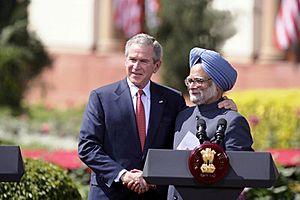India–United States Civil Nuclear Agreement facts for kids
The U.S.–India Civil Nuclear Agreement, also known as the Indo-US nuclear deal, was a special agreement signed between the United States and India. It allowed India to get nuclear technology and fuel for peaceful purposes, even though India had nuclear weapons and was not part of a big international treaty called the Non-Proliferation Treaty (NPT). This deal was a big step in the relationship between the two countries.
Contents
How the Deal Started
The idea for this agreement began on July 18, 2005. At that time, Manmohan Singh was the Prime Minister of India, and George W. Bush was the President of the United States. They made a joint statement, which is like a public promise, about working together on nuclear energy.
What India Agreed To
For the deal to happen, India made some important promises:
- India agreed to separate its nuclear facilities into two types: those for peaceful energy (civilian) and those for military uses (weapons).
- India promised to let the International Atomic Energy Agency (IAEA) inspect all its civilian nuclear facilities. The IAEA is like a global watchdog that makes sure nuclear materials are used safely and peacefully.
What the U.S. Agreed To
In return, the United States agreed to help India with its civilian nuclear program. This meant the U.S. would work towards allowing India to access nuclear technology and fuel from other countries for energy production.
Making the Deal Happen
It took more than three years for the U.S.-India nuclear deal to become a reality. Many steps had to be completed:
- The U.S. had to change some of its own laws.
- India had to create a detailed plan to separate its civilian and military nuclear sites. This was called the "Separation Plan."
- India had to sign a special agreement with the IAEA for inspections.
- A group of countries called the Nuclear Suppliers Group (NSG) had to agree to let India buy nuclear materials. The NSG controls the trade of nuclear technology, and it was originally formed partly because India had tested a nuclear weapon in 1974.
Final Agreement Details
When the deal was finalized, it meant that India's civilian nuclear facilities would always be inspected by the IAEA. The agreement allowed a lot of cooperation on peaceful nuclear energy. However, it did not allow the transfer of very "sensitive" equipment or technologies, like those used for enriching uranium or reprocessing nuclear fuel, even if they were under IAEA inspections.
On August 18, 2008, the IAEA approved the safeguards agreement with India. India officially signed this agreement on February 2, 2009. After that, inspections began at the 35 civilian nuclear sites India had listed in its Separation Plan.
A New Chapter in Relations
This deal was a huge moment for U.S.-India relations. It also brought a new way of thinking about how to prevent the spread of nuclear weapons around the world.
On August 1, 2008, after the IAEA approved the safeguards, the U.S. asked the Nuclear Suppliers Group (NSG) to give India a special permission, or "waiver," to start trading in civilian nuclear technology. The NSG, which has 48 member countries, agreed to this waiver on September 6, 2008. This allowed India to buy and sell civilian nuclear technology and fuel from other countries.
This made India unique. It became the only country with nuclear weapons that was not part of the Non-Proliferation Treaty (NPT) but was still allowed to trade nuclear materials with the rest of the world for peaceful purposes.
Approvals and Signing
The deal then went through the final stages of approval in the United States:
- The United States House of Representatives voted to approve the deal on September 28, 2008.
- Just two days later, India and France signed a similar nuclear agreement, making France the first country to have such a pact with India.
- On October 1, 2008, the United States Senate also approved the civilian nuclear agreement. This meant India could buy and sell nuclear fuel and technology with the United States.
On October 8, 2008, U.S. President George W. Bush signed the approved legislation into law. It was officially named the United States-India Nuclear Cooperation Approval and Non-proliferation Enhancement Act. Finally, the agreement was formally signed on October 10 by India's External Affairs Minister, Pranab Mukherjee, and the U.S. Secretary of State, Condoleezza Rice.
Later Developments
Even after all the approvals, the agreement took more time to be fully put into action.
- By 2015, the deal was still not completely implemented.
- In 2016, the United States and India agreed to build six nuclear reactors in India that would use U.S. designs.


